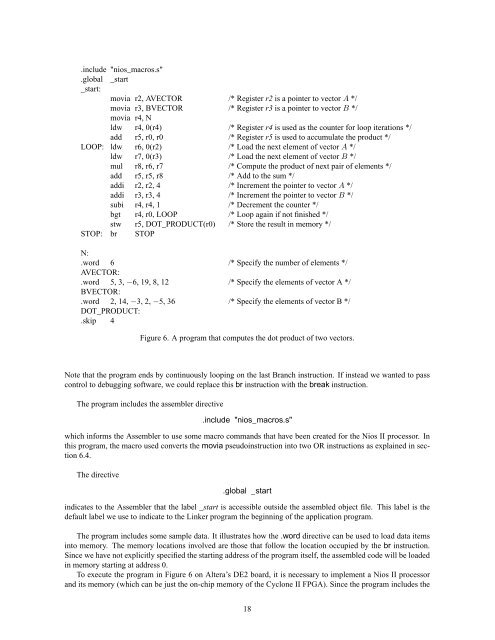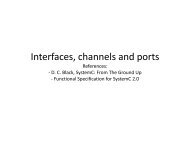Introduction to the Altera Nios II Soft Processor - FTP - Altera
Introduction to the Altera Nios II Soft Processor - FTP - Altera
Introduction to the Altera Nios II Soft Processor - FTP - Altera
Create successful ePaper yourself
Turn your PDF publications into a flip-book with our unique Google optimized e-Paper software.
.include "nios_macros.s"<br />
.global _start<br />
_start:<br />
movia r2, AVECTOR /* Register r2 is a pointer <strong>to</strong> vec<strong>to</strong>r A */<br />
movia r3, BVECTOR /* Register r3 is a pointer <strong>to</strong> vec<strong>to</strong>r B */<br />
movia r4, N<br />
ldw r4, 0(r4) /* Register r4 is used as <strong>the</strong> counter for loop iterations */<br />
add r5, r0, r0 /* Register r5 is used <strong>to</strong> accumulate <strong>the</strong> product */<br />
LOOP: ldw r6, 0(r2) /* Load <strong>the</strong> next element of vec<strong>to</strong>r A */<br />
ldw r7, 0(r3) /* Load <strong>the</strong> next element of vec<strong>to</strong>r B */<br />
mul r8, r6, r7 /* Compute <strong>the</strong> product of next pair of elements */<br />
add r5, r5, r8 /* Add <strong>to</strong> <strong>the</strong> sum */<br />
addi r2, r2, 4 /* Increment <strong>the</strong> pointer <strong>to</strong> vec<strong>to</strong>r A */<br />
addi r3, r3, 4 /* Increment <strong>the</strong> pointer <strong>to</strong> vec<strong>to</strong>r B */<br />
subi r4, r4, 1 /* Decrement <strong>the</strong> counter */<br />
bgt r4, r0, LOOP /* Loop again if not finished */<br />
stw r5, DOT_PRODUCT(r0) /* S<strong>to</strong>re <strong>the</strong> result in memory */<br />
STOP: br STOP<br />
N:<br />
.word 6 /* Specify <strong>the</strong> number of elements */<br />
AVECTOR:<br />
.word 5, 3, −6, 19, 8, 12 /* Specify <strong>the</strong> elements of vec<strong>to</strong>r A */<br />
BVECTOR:<br />
.word 2, 14, −3, 2, −5, 36 /* Specify <strong>the</strong> elements of vec<strong>to</strong>r B */<br />
DOT_PRODUCT:<br />
.skip 4<br />
Figure 6. A program that computes <strong>the</strong> dot product of two vec<strong>to</strong>rs.<br />
Note that <strong>the</strong> program ends by continuously looping on <strong>the</strong> last Branch instruction. If instead we wanted <strong>to</strong> pass<br />
control <strong>to</strong> debugging software, we could replace this br instruction with <strong>the</strong> break instruction.<br />
The program includes <strong>the</strong> assembler directive<br />
.include "nios_macros.s"<br />
which informs <strong>the</strong> Assembler <strong>to</strong> use some macro commands that have been created for <strong>the</strong> <strong>Nios</strong> <strong>II</strong> processor. In<br />
this program, <strong>the</strong> macro used converts <strong>the</strong> movia pseudoinstruction in<strong>to</strong> two OR instructions as explained in section<br />
6.4.<br />
The directive<br />
.global _start<br />
indicates <strong>to</strong> <strong>the</strong> Assembler that <strong>the</strong> label _start is accessible outside <strong>the</strong> assembled object file. This label is <strong>the</strong><br />
default label we use <strong>to</strong> indicate <strong>to</strong> <strong>the</strong> Linker program <strong>the</strong> beginning of <strong>the</strong> application program.<br />
The program includes some sample data. It illustrates how <strong>the</strong> .word directive can be used <strong>to</strong> load data items<br />
in<strong>to</strong> memory. The memory locations involved are those that follow <strong>the</strong> location occupied by <strong>the</strong> br instruction.<br />
Since we have not explicitly specified <strong>the</strong> starting address of <strong>the</strong> program itself, <strong>the</strong> assembled code will be loaded<br />
in memory starting at address 0.<br />
To execute <strong>the</strong> program in Figure 6 on <strong>Altera</strong>’s DE2 board, it is necessary <strong>to</strong> implement a <strong>Nios</strong> <strong>II</strong> processor<br />
and its memory (which can be just <strong>the</strong> on-chip memory of <strong>the</strong> Cyclone <strong>II</strong> FPGA). Since <strong>the</strong> program includes <strong>the</strong><br />
18

















